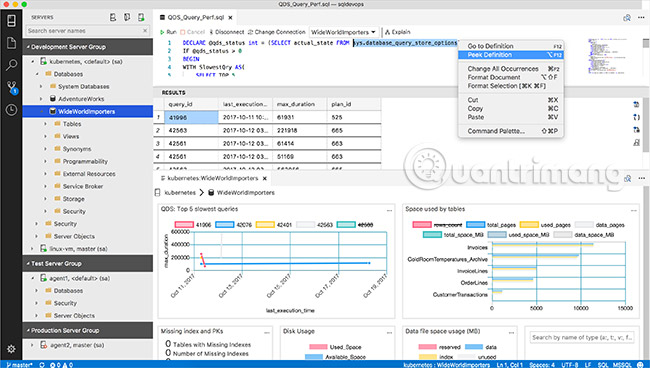Manage servers and databases with detailed utilities in SQL Operations Studio (preview)
Detailed utilities retrieve the Transact-SQL (T-SQL) queries you use to monitor servers and databases, then turn them into visual images.
Detailed utilities are customizable graphs and charts, which you add to the dashboard page to monitor the server and database. Take a look at the detailed utilities of your server and database, then see more details and launch management actions that you define.
You can build dashboard pages to manage servers and excellent databases, similar to the following example:

SQL query
SQL Operations Studio (preview) tries to avoid introducing another heavy language or user interface, and trying to use T-SQL as much as possible with the minimum JSON configuration. Configure detailed utilities with T-SQL, take advantage of the countless useful T-SQL query sources that are currently available and can be turned into really useful utilities.
Detailed utilities include one or two T-SQL queries:
- The Insight widget query is required and the query returns data that appears in the widget.
- Insight details query is only required if you are creating a detailed information page inside.
Detailed utility queries that define the data set showing numbers, graphs, or charts. Detailed queries of detailed utilities are used to list relevant details in tabular format, in the Insight details panel .
SQL Operations Studio (preview) performs detailed utility queries and maps the query result set to the chart's data set, then displays it. When the user opens the details of the detailed utility, it will perform a detailed query about that detailed utility and print the result in a grid view in the dialog box.
The basic idea is to write a T-SQL query, in such a way that it can be used as a data file of counting utilities, charts and graphs.
Its T-SQL query and result set determine the behavior of the detailed utility. Writing a query for a chart type or mapping an appropriate chart type for an existing query is the main consideration for building an effective detailed utility.
See more:
- CREATE LOGIN command in SQL Server
- Grant / Revoke permissions in SQL Server
- Index in SQL Server
You should read it
- Use code to quickly create T-SQL scripts in SQL Operations Studio (preview)
- Shortcuts in Camtasia Studio
- Keyboard shortcuts in Visual Studio - All common keyboard shortcuts in Visual Studio
- Steps to Install Visual Studio: Powerful Microsoft Programming Tool
- 6 notable differences between Mac Studio and Mac Pro
- Roblox Studio
- Microsoft announced the launch of Visual Studio 2019
- Dell is about to release Studio XPS 15 and 17 inches
May be interested
- UPDATE command in SQL
 update is the query used to edit existing records in the table. you can use the where clause with the update statement to update selected rows, if not all rows in the table are affected.
update is the query used to edit existing records in the table. you can use the where clause with the update statement to update selected rows, if not all rows in the table are affected. - Boolean operators AND and OR in SQL
 the and and or operators are used to combine multiple conditions to narrow the data in sql statements. these two operators are called conjugate operators in sql. and and or allow multiple comparisons with other operators in the same sql statement.
the and and or operators are used to combine multiple conditions to narrow the data in sql statements. these two operators are called conjugate operators in sql. and and or allow multiple comparisons with other operators in the same sql statement.


 Integrated terminal in SQL Operations Studio (preview)
Integrated terminal in SQL Operations Studio (preview) Use code to quickly create T-SQL scripts in SQL Operations Studio (preview)
Use code to quickly create T-SQL scripts in SQL Operations Studio (preview) Learn about Microsoft Operations Studio from Microsoft
Learn about Microsoft Operations Studio from Microsoft How to easily manage databases with phpMyAdmin
How to easily manage databases with phpMyAdmin Shortcuts in Camtasia Studio
Shortcuts in Camtasia Studio